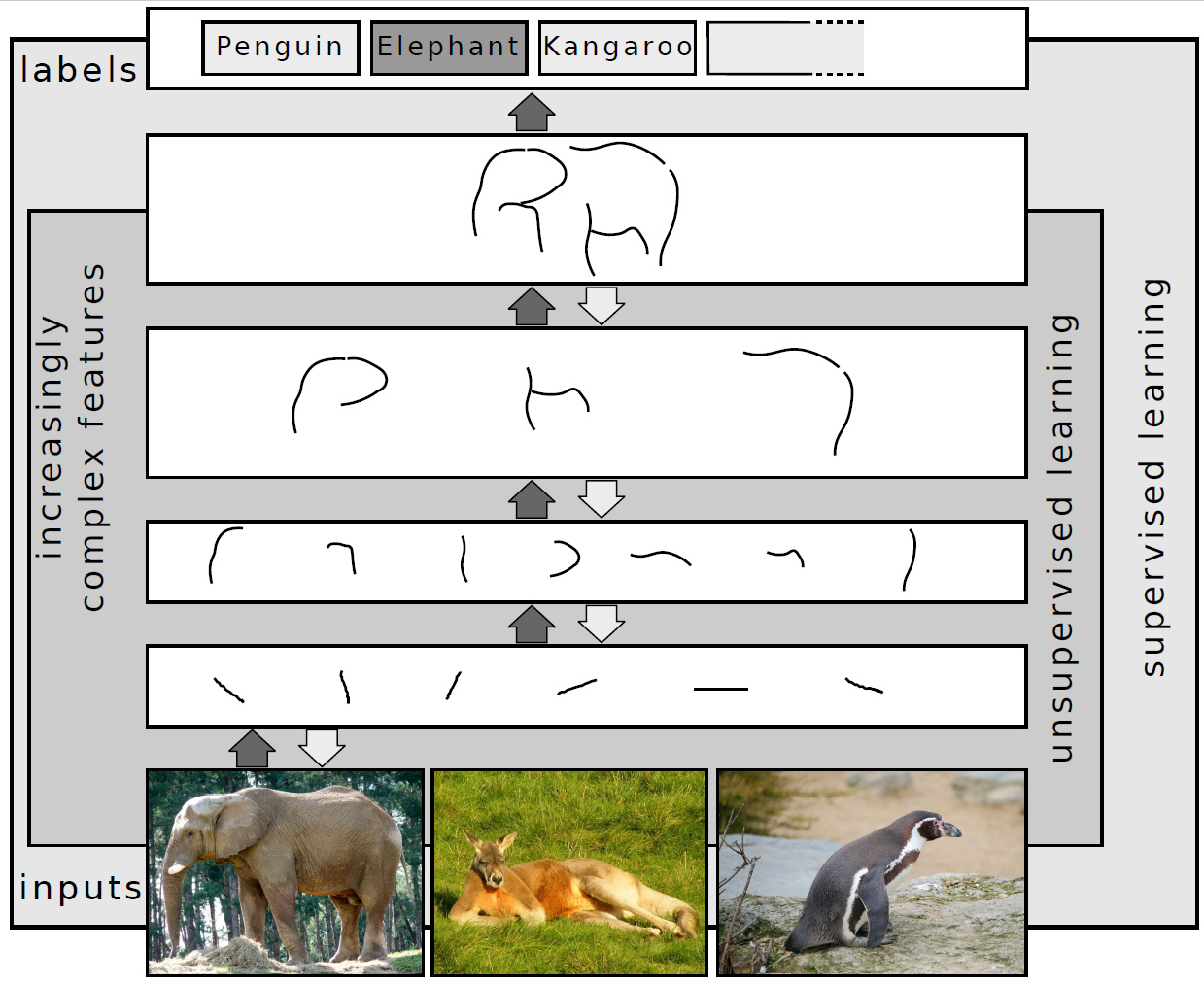|
ImageNet
The ImageNet project is a large visual database designed for use in Outline of object recognition, visual object recognition software research. More than 14 million images have been hand-annotated by the project to indicate what objects are pictured and in at least one million of the images, bounding boxes are also provided. ImageNet contains more than 20,000 categories, with a typical category, such as "balloon" or "strawberry", consisting of several hundred images. The database of annotations of third-party image URLs is freely available directly from ImageNet, though the actual images are not owned by ImageNet. Since 2010, the ImageNet project runs an annual software contest, the ImageNet Large Scale Visual Recognition Challenge (#History_of_the_ImageNet_challenge, ILSVRC), where software programs compete to correctly classify and detect objects and scenes. The challenge uses a "trimmed" list of one thousand non-overlapping classes. History AI researcher Fei-Fei Li began working ... [...More Info...] [...Related Items...] OR: [Wikipedia] [Google] [Baidu] |
AlexNet
AlexNet is a convolutional neural network architecture developed for image classification tasks, notably achieving prominence through its performance in the ImageNet Large Scale Visual Recognition Challenge (ILSVRC). It classifies images into 1,000 distinct object categories and is regarded as the first widely recognized application of deep convolutional networks in large-scale visual recognition. Developed in 2012 by Alex Krizhevsky in collaboration with Ilya Sutskever and his Ph.D. advisor Geoffrey Hinton at the University of Toronto, the model contains 60 million parameters and 650,000 neurons. The original paper's primary result was that the depth of the model was essential for its high performance, which was computationally expensive, but made feasible due to the utilization of graphics processing units (GPUs) during training. The three formed team SuperVision and submitted AlexNet in the ImageNet Large Scale Visual Recognition Challenge on September 30, 2012. The network ... [...More Info...] [...Related Items...] OR: [Wikipedia] [Google] [Baidu] |
Fei-Fei Li
Fei-Fei Li (; born in Beijing, China, July 3, 1976) is a Chinese-American computer scientist known for her pioneering work in artificial intelligence (AI), particularly in computer vision. She is best known for establishing ImageNet, the dataset that enabled rapid advances in computer vision in the 2010s. She is the Sequoia Capital professor of computer science at Stanford University and former board director at Twitter. Li is a co-director of the Stanford Institute for Human-Centered Artificial Intelligence and a co-director of the Stanford Vision and Learning Lab. She also served as Chief Scientist of AI/ML at Google Cloud and is the director of the Stanford Artificial Intelligence Laboratory from 2013 to 2018. In 2017, she co-founded AI4ALL, a nonprofit organization working to increase diversity and inclusion in the field of artificial intelligence. Her research expertise includes artificial intelligence, machine learning, deep learning, computer vision and cognitive neur ... [...More Info...] [...Related Items...] OR: [Wikipedia] [Google] [Baidu] |
Convolutional Neural Network
A convolutional neural network (CNN) is a type of feedforward neural network that learns features via filter (or kernel) optimization. This type of deep learning network has been applied to process and make predictions from many different types of data including text, images and audio. Convolution-based networks are the de-facto standard in deep learning-based approaches to computer vision and image processing, and have only recently been replaced—in some cases—by newer deep learning architectures such as the transformer. Vanishing gradients and exploding gradients, seen during backpropagation in earlier neural networks, are prevented by the regularization that comes from using shared weights over fewer connections. For example, for ''each'' neuron in the fully-connected layer, 10,000 weights would be required for processing an image sized 100 × 100 pixels. However, applying cascaded ''convolution'' (or cross-correlation) kernels, only 25 weights for each convolutio ... [...More Info...] [...Related Items...] OR: [Wikipedia] [Google] [Baidu] |
ResNets
A residual neural network (also referred to as a residual network or ResNet) is a deep learning architecture in which the layers learn residual functions with reference to the layer inputs. It was developed in 2015 for image recognition, and won the ImageNet Large Scale Visual Recognition ChallengeILSVRC of that year. As a point of terminology, "residual connection" refers to the specific architectural motif of , where f is an arbitrary neural network module. The motif had been used previously (see §History for details). However, the publication of ResNet made it widely popular for feedforward networks, appearing in neural networks that are seemingly unrelated to ResNet. The residual connection stabilizes the training and convergence of deep neural networks with hundreds of layers, and is a common motif in deep neural networks, such as transformer models (e.g., BERT, and GPT models such as ChatGPT), the AlphaGo Zero system, the AlphaStar system, and the AlphaFold system. ... [...More Info...] [...Related Items...] OR: [Wikipedia] [Google] [Baidu] |
WordNet
WordNet is a lexical database of semantic relations between words that links words into semantic relations including synonyms, hyponyms, and meronyms. The synonyms are grouped into ''synsets'' with short definitions and usage examples. It can thus be seen as a combination and extension of a dictionary and thesaurus. Its primary use is in automatic natural language processing, text analysis and artificial intelligence applications. It was first created in the English language and the English WordNet database and software tools have been released under a BSD License, BSD style license and are freely available for download. The latest official release from Princeton was released in 2011. Princeton currently has no plans to release any new versions due to staffing and funding issues. New versions are still being released annually through the Open English WordNet website. Until about 2024 an online version was previously available through wordnet.princeton.edu. That version of WordNet h ... [...More Info...] [...Related Items...] OR: [Wikipedia] [Google] [Baidu] |
Deep Learning
Deep learning is a subset of machine learning that focuses on utilizing multilayered neural networks to perform tasks such as classification, regression, and representation learning. The field takes inspiration from biological neuroscience and is centered around stacking artificial neurons into layers and "training" them to process data. The adjective "deep" refers to the use of multiple layers (ranging from three to several hundred or thousands) in the network. Methods used can be either supervised, semi-supervised or unsupervised. Some common deep learning network architectures include fully connected networks, deep belief networks, recurrent neural networks, convolutional neural networks, generative adversarial networks, transformers, and neural radiance fields. These architectures have been applied to fields including computer vision, speech recognition, natural language processing, machine translation, bioinformatics, drug design, medical image analysis, c ... [...More Info...] [...Related Items...] OR: [Wikipedia] [Google] [Baidu] |
Christiane Fellbaum
Christiane D. Fellbaum is an American linguist and computational linguistics researcher who is Lecturer with Rank of Professor in the Program in Linguistics and the Computer Science Department at Princeton University. The co-developer of the WordNet project, she is also its current director. Biography Fellbaum received a Ph.D. from Princeton University in linguistics in 1980 and later joined Princeton's Cognitive Science Laboratory, working with George Armitage Miller. Together with Miller and his team, she was a creator of WordNet, a large lexical database that serves as a widely used resource in computational linguistics and natural language processing. Many researchers have since built upon her work, including AI researcher Fei-Fei Li, the inventor of ImageNet, which was inspired by a 2006 conversation with Fellbaum as well as by the name and design of the original WordNet. She is a founder and president of the Global WordNet Association, which guides the construction of lexic ... [...More Info...] [...Related Items...] OR: [Wikipedia] [Google] [Baidu] |
RGB Color Model
The RGB color model is an additive color, additive color model in which the red, green, and blue primary colors of light are added together in various ways to reproduce a broad array of colors. The name of the model comes from the initials of the three additive primary colors, red, green, and blue. The main purpose of the RGB color model is for the sensing, representation, and display of images in electronic systems, such as televisions and computers, though it has also been used in conventional photography and Light-emitting diode#RGB systems, colored lighting. Before the electronic age, the RGB color model already had a solid theory behind it, based in Trichromacy, human perception of colors. RGB is a ''device-dependent'' color model: different devices detect or reproduce a given RGB value differently, since the color elements (such as phosphors or dyes) and their response to the individual red, green, and blue levels vary from manufacturer to manufacturer, or even in the ... [...More Info...] [...Related Items...] OR: [Wikipedia] [Google] [Baidu] |
Flickr
Flickr ( ) is an image hosting service, image and Online video platform, video hosting service, as well as an online community, founded in Canada and headquartered in the United States. It was created by Ludicorp in 2004 and was previously a common way for amateur and professional photographers to host high-resolution photos. It has changed ownership several times and has been owned by SmugMug since April 20, 2018. Flickr had a total of 112 million registered members and more than 3.5 million new images uploaded daily. On August 5, 2011, the site reported that it was hosting more than 6 billion images. In 2024, it was reported as having shared 10 billion photos and accepting 25 million per day. Photos and videos can be accessed from Flickr without the need to register an account, but an account must be made to upload content to the site. Registering an account also allows users to create a profile page containing photos and videos that the user has uploaded and also grants the ... [...More Info...] [...Related Items...] OR: [Wikipedia] [Google] [Baidu] |
Yahoo
Yahoo (, styled yahoo''!'' in its logo) is an American web portal that provides the search engine Yahoo Search and related services including My Yahoo, Yahoo Mail, Yahoo News, Yahoo Finance, Yahoo Sports, y!entertainment, yahoo!life, and its advertising platform, Yahoo Native. It is operated by the namesake company Yahoo! Inc., which is 90% owned by Apollo Global Management and 10% by Verizon. Yahoo was established by Jerry Yang and David Filo in January 1994 and was one of the pioneers of the early Internet era in the 1990s. However, its use declined in the 2010s as some of its services were discontinued, and it lost market share to Facebook and Google. Etymology The word "yahoo" is a backronym for " Yet Another Hierarchically Organized Oracle" or "Yet Another Hierarchical Officious Oracle". The term "hierarchical" described how the Yahoo database was arranged in layers of subcategories. The term "oracle" was intended to mean "source of truth and wisdom", and ... [...More Info...] [...Related Items...] OR: [Wikipedia] [Google] [Baidu] |
Synset
In metadata, a synonym ring or synset, is a group of data elements that are considered semantically equivalent for the purposes of information retrieval. These data elements are frequently found in different metadata registries. Although a group of terms can be considered equivalent, metadata registries store the synonyms at a central location called the preferred data element. According to WordNet, a ''synset'' or synonym set is defined as a set of one or more synonyms that are interchangeable in some context without changing the truth value of the proposition in which they are embedded. Example The following are considered semantically equivalent and form a synonym ring: foaf:person gjxdm:Person niem:Person sumo:Human cyc:Person umbel:Person Note that each data element has two components: # Namespace prefix, which is a shorthand for the name of the metadata registry # Data element name, which is the name of the object in each of the distinct metadata registry ... [...More Info...] [...Related Items...] OR: [Wikipedia] [Google] [Baidu] |




